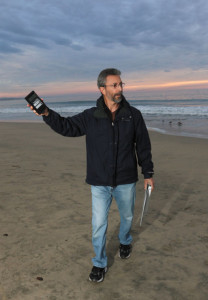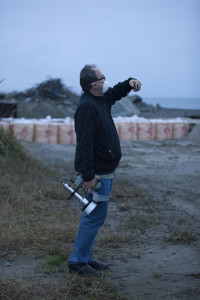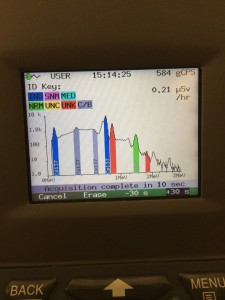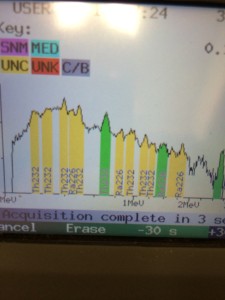We continue our investigation into the beautiful mysterious black sand at Surferʻs Beach. This video documents our visit to the beach, and what we have found so far.
Link to Geiger Counter Bulletin YouTube Channel
Comments closed
We live in a cosmic sea of radiation...
What can a geiger counter teach us?
What hidden secrets can a geiger counter reveal?
How can a geiger counter protect us?
We continue our investigation into the beautiful mysterious black sand at Surferʻs Beach. This video documents our visit to the beach, and what we have found so far.
Link to Geiger Counter Bulletin YouTube Channel
Comments closedOpinions expressed in this article reflect only the authorʻs viewpoint.
Earlier blogposts here identified elevated radiation levels at Surferʻs Beach in Half Moon Bay as “not from Fukushima.” After a trip to the site and further analysis, I stand by that conclusion. I will publish more on that here soon. I hope this alleviates concern across the Pacific Rim, because it should.
Independent Safecast has put together a compilation of information on Fukushima Daiichi impacts on the ocean here.
California State Office of Emergency Services (CalOES) has informed me that California Department of Public Health (CDPH) is doing further testing on samples taken from Half Moon Bay. They will post the results here.
I applaud CDPH for taking a precautionary approach.
I think this is a good idea for a number of reasons. Most importantly, it will help build trust that this beautiful beach is a safe place for children. I have requested further details of the nature of the testing.
I hope that a full chemical and spectral analysis will be done to determine without doubt that these naturally occurring radionuclides are native to this beach and not introduced.
Part of my cautious approach to this is the public knowledge that radioactive materials were dumped at the Farallon Islands, approximately 35 miles offshore from Half Moon Bay. There are also other sites in the Bay Area contaminated with TENORM materials, notably Treasure Island and Hunterʻs Point.
Further testing will help build public confidence that California is a place where transparency thrives, where our public officials are proactive in protecting the public health, and where our beaches are safe. I hope and expect that will be the conclusion, and again thank CDPH for further testing.
CalOES asked me to post this message:
“There is no public health risk at California beaches due to radioactivity related to events at Fukushima . The California Department of Public Health (CDPH) is not aware of any recent activity at Fukushima, or any new data that would cause elevated radioactivity on California shores from the Fukushima incident. Recent tests by the San Mateo County public health department and CDPH show that elevated levels of radiation at Half Moon Bay are due to naturally occurring materials and not radioactivity associated with the Fukushima incident.
The volume of water in the Pacific Ocean has a significant diluting effect on radionuclides that are present and it is not anticipated that the concentration will increase in the waters off of the west coast. CDPH has collected and will be analyzing sand samples from Half Moon Bay. Results of the analysis will be posted on the CDPH Radiologic Health (RHB) website (http://www.cdph.ca.gov/programs/Pages/RHB-RadReport.aspx) as soon as the analysis is completed.”
Other information:
CDPH also performs routine air and milk samples as required by California law. Slightly elevated air and milk samples were found during the initial phases of the Fukushima incident (March 2011) and the results were reported on CDPH RHB’s website (see link above). CDPH continues to monitor air, milk, kelp, and fish samples. CDPH’s monitoring is part of its on-going environmental monitoring program and will be publishing data on the CDPH RHB website by the end of this week.
CDPH has been in contact with the U.S. Nuclear Regulatory Commission (NRC) and they are monitoring the situation with the nuclear reactors in Japan. The FDA as well as the private entity Woods- Hole Oceanographic Institution (WHOI) have monitored fish from the Pacific and while minute levels of cesium were found in blue fin tuna most recent tests show even those small levels are declining. The United States Environmental Protection Agency (USEPA) is the coordinating Agency for response to international emergencies involving radioactive materials and the FDA is responsible for food safety. FDA’s hotline number is 888-723-3366. The USEPA, via their RadNet system, monitors the nation’s air, drinking water, precipitation, and pasteurized milk to determine levels of radiation in the environment. RadNet sample analyses and monitoring results provide baseline data on background levels of radiation in the environment and can detect increased radiation from radiological incidents, such as the Fukushima incident. You may visit the USEPA RadNet website at http://www.epa.gov/radnet/ and this site has a link regarding public questions.
Some additional useful links:
The National Oceanographic and Atmospheric Administration (NOAA) addresses threats to coastal areas. You can see information about their tracking of debris from Japan at:
http://marinedebris.noaa.gov/tsunamidebris/
The International Atomic Energy Agency (IAEA) provides publically available reports on leakage and sea water radioactivity near the Fukushima Daiichi plant. The last report can be found at: http://www.iaea.org/newscenter/news/2013/japan-basic-policy6.html
The state of Oregon continues to test drinking water, rain water and sea water for radionuclides that could be associated with Fukushima.
Comments closedA good Geiger Counter can be an invaluable tool. It can tell you a lot. With one, you can see what is invisible to human eyes and other human sensory systems. You can then use that information to take appropriate action if you see something unusual. Knowing that you have that ability can empower you – and give you peace of mind.
The humble Geiger Counter, used with some skill and knowledge, can save lives and prevent suffering. It can also be used as a tool for learning about the natural world around us, which is truly fascinating.
But Geiger Counters give you a limited view at relatively low cost – only a peak into that invisible realm. The veil becomes lifted, but you have to use some scientific method, understand the rules, sometimes consult other instruments, to get a definitive picture of a given situation.
Interpreting or misinterpreting what you are detecting can be a learning experience, and, when you share it on YouTube, well….a lot of us got a learning experience over the holidays.
The YouTube video of a Geiger Counter on a beach at Half Moon Bay went viral. It was viewed over 600,000 times in a couple of weeks. Speculation was that unusual readings meant something from Fukushima had arrived on the West Coast. People along coastlines throughout the Pacific Rim became concerned.
It was not just the video of an innocent guy, a concerned citizen, finding something radioactive and jumping to conclusions. It was the combination of that, combined with a lot of fear mongering by other people (not connected to him) on various websites – about crazy scenarios unfolding at Fukushima Daiichi. Azby Brown at Safecast Japan covered some of those stories here. I asked people to consider not forwarding email or web links that donʻt ring true here.
During this period I heard reports of people taking potassium iodide, duct taping themselves into rooms, and refraining from eating anything from the ocean, or even fresh vegetables.
I monitor for radiation daily and I volunteer for Safecast. I trust their data and their team to be rock solid. I knew there was no massive radiation event happening. A close friend and trusted partner, Steve Weiss, lives on Half Moon Bay – near the beach in question. He and I have been working together in the radiation detection field for over 35 years. We were designers of the original Inspector almost 25 years ago. Reports of beach contamination were based an Inspector reading. Thus we felt an added sense of responsibility in this situation. Steve rushed me a bag of sand from from one of the areas of concern on the beach. I analyzed it and reported the data to Safecast and to this blogpost.

Sean Bonner of Safecast also did some research and posted his findings here. There was a lot of Trans-California and Trans-Pacific collaboration going on. A few days later, Health Officials confirmed our preliminary conclusions, as reported by Half Moon Bay Patch here.

Why did we have confidence that the elevated readings were not from Fukushima? Hard earned experience, and different technology. I traveled to inhabited areas of Fukushima Prefecture with Sean and other Safecasters in December 2011, carrying a multichannel analyzer. The spectra on the sand on the beach in Iwaki did not look anything like the sand at Half Moon Bay. See the spectra below.


I guess the moral of this holiday story is donʻt believe everything you hear on the internet, and also remember that a Geiger Counter can only give you a limited view of a new situation. Try not to jump to conclusions until you have all the information. There are many sources of radiation in medicine, in homes and workplaces, and in the natural environment.
The spectra of radioactive isotopes are now well documented in Fukushima. The data from Geiger Counters are invaluable over there, and there is no need to constantly collect new spectral data. Half Moon Bay was a completely different situation – and it took some other tools and some research to sort it out.
I hope everyone knows that Potassium Iodide should not be taken lightly. There are adverse reactions reported, and it should not be taken by pregnant women. Itʻs value is actually controversial. If there is value in taking it, itʻs only when radioactive forms of iodine are present in the air, food or beverages. To my knowledge, this is not an issue at this point in time.
Iʻm very heartened that many people with diverse interests and concerns worked hard over the holidays to counter the apocalyptic internet reports about Fukushima Daiichi problems, and to help the general population calm down.
Comments closed